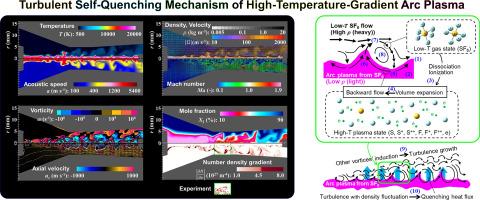Turbulent self-quenching mechanism of high-temperature-gradient arc plasma in a converging–diverging cylinder: a numerical study
IF 5.8
2区 工程技术
Q1 ENGINEERING, MECHANICAL
International Journal of Heat and Mass Transfer
Pub Date : 2025-06-02
DOI:10.1016/j.ijheatmasstransfer.2025.127291
引用次数: 0
Abstract
Thermofluid dynamic behaviours of SF6 and air flows including arc plasma and non-ionized gas in a converging–diverging cylinder were studied numerically. The arc plasma in SF6 gas was constricted with high temperatures exceeding 20 000 K. It formed a slightly compressible and subsonic flow, whereas the ambient non-ionized gas had temperatures below 1000 K and a compressible flow with island-like supersonic flow zones. The arc plasma in air gas had temperatures lower than 12 000 K and a blurred fringe with a low gradient. The entire fluid region including the plasma formed an incompressible and subsonic flow. The different temperature distributions were attributed to differences of their thermal diffusivities and Reynolds numbers. For the SF6 flow system, SF6 molecules dissociated in the arc plasma to seven atoms. They were ionized to their ions and electrons, causing considerably greater volume expansion and generating both forward and backward flows locally. Impingements of those flows occurred locally. The generated vortices conveyed the thermal energy outward. Great degrees of turbulent mixing of the thermal energy occurred with the mass density fluctuation, which produced outward heat flux much stronger than that produced by either convection or conduction. The arc plasma was quenched effectively.

高温梯度电弧等离子体在会聚-发散圆柱体中的湍流自猝灭机制:数值研究
数值研究了SF6与电弧等离子体和非电离气体在会聚发散圆柱体中的热流动力学行为。SF6气体中的电弧等离子体在超过20000 K的高温下收缩。它形成了一个微可压缩的亚音速流动,而周围的非电离气体的温度低于1000 K,是一个具有岛状超音速流区的可压缩流动。空气中的电弧等离子体温度低于12 000 K,条纹模糊,梯度低。包括等离子体在内的整个流体区域形成了不可压缩的亚音速流。温度分布的不同是由于它们的热扩散率和雷诺数的不同。对于SF6流动系统,SF6分子在电弧等离子体中解离成7个原子。它们被电离成离子和电子,造成相当大的体积膨胀,并在局部产生向前和向后的流动。这些水流的撞击发生在局部。产生的涡流将热能向外传递。随着质量密度的波动,热能发生了很大程度的湍流混合,产生的向外热流比对流或传导产生的热流强得多。电弧等离子体得到了有效的淬火。
本文章由计算机程序翻译,如有差异,请以英文原文为准。
求助全文
约1分钟内获得全文
求助全文
来源期刊
CiteScore
10.30
自引率
13.50%
发文量
1319
审稿时长
41 days
期刊介绍:
International Journal of Heat and Mass Transfer is the vehicle for the exchange of basic ideas in heat and mass transfer between research workers and engineers throughout the world. It focuses on both analytical and experimental research, with an emphasis on contributions which increase the basic understanding of transfer processes and their application to engineering problems.
Topics include:
-New methods of measuring and/or correlating transport-property data
-Energy engineering
-Environmental applications of heat and/or mass transfer

 求助内容:
求助内容: 应助结果提醒方式:
应助结果提醒方式:


